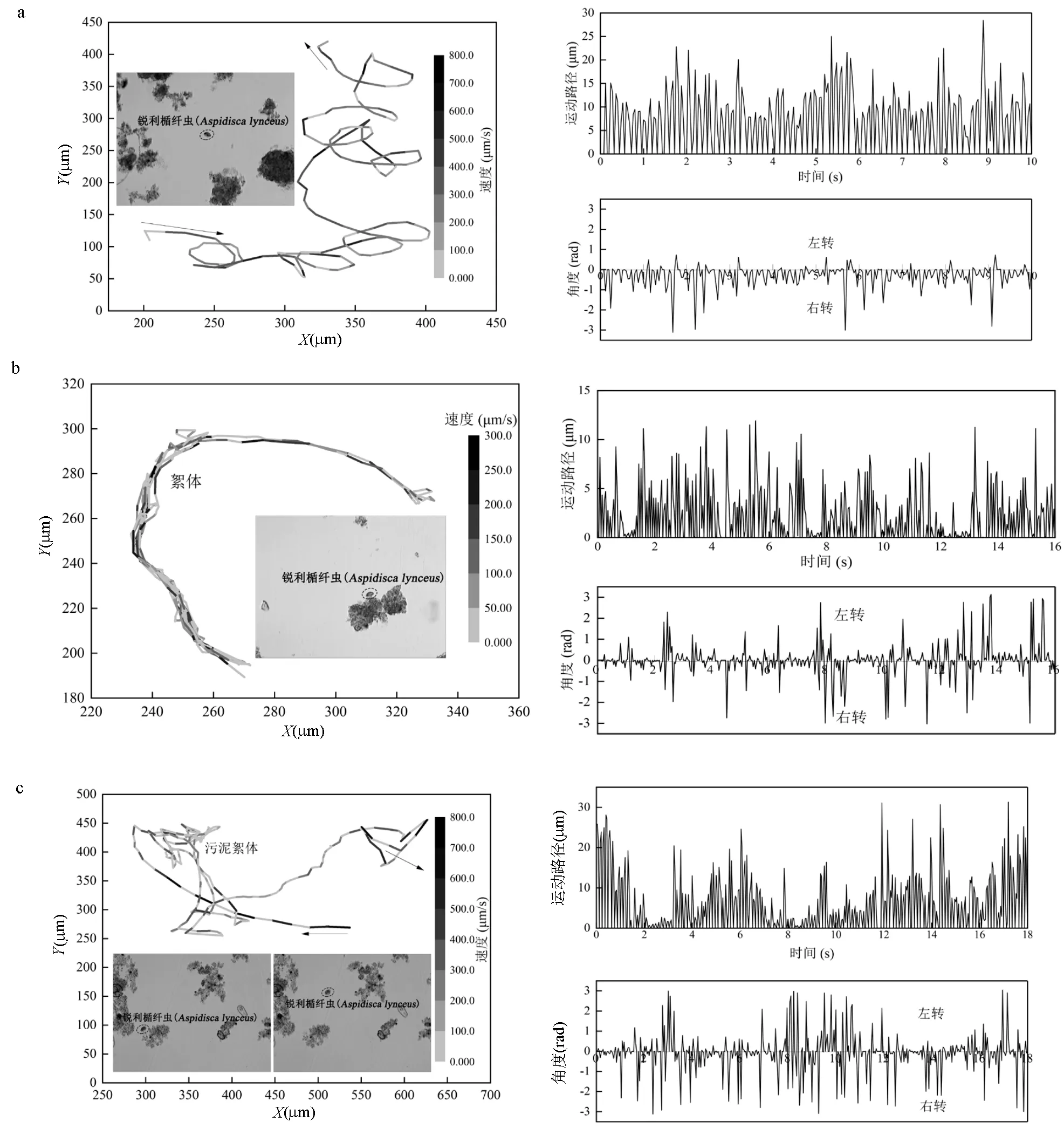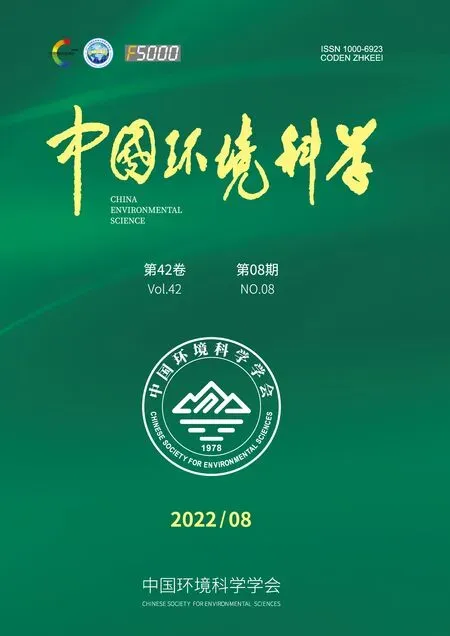污泥絮体特征与微型动物运动速度相关性研究——以自由运动型微型动物为例
胡小兵,汪 坤,李晶晶,陈红伟,宋维维,江用彬,2,常 静,钟梅英
污泥絮体特征与微型动物运动速度相关性研究——以自由运动型微型动物为例
胡小兵1,2*,汪 坤1,李晶晶1,陈红伟1,宋维维1,江用彬1,2,常 静1,钟梅英1
(1.安徽工业大学建筑工程学院,安徽 马鞍山 243002;2.生物膜法水质净化及利用技术教育部工程研究中心,安徽 马鞍山 243032)

絮体微观形态参数;PCA法;微型动物;运动速度;活性污泥
活性污泥絮体是由微生物(细菌、真菌和微型动物等)与其代谢产物及所吸附的有机、无机物混合组成[1],表面凹凸不平,形态结构多样[2].絮体作为活性污泥法中的微型生物处理单元,承担着有机污染物降解的重要作用[3].絮体的结构特征可用于污泥物理特性、生化活性以及废水处理效果的判断[4].目前活性污泥絮体的结构特征分析主要有定量图像分析法[5]和分形理论法[6-7],后者对于絮体结构特征描述主要集中于理论分析与计算机数值模拟分析,缺少对分形结构理论完整性的系统表达[8].前者主要运用显微成像系统采集絮体图片,利用定量图像分析法(QIA)对絮体的平均面积、孔隙面积率、圆度、当量直径、最大Feret直径等基本参数进行测量[9-10].但分析过多的基本描述参数将会加大分析负担与难度,且容易造成基本描述参数携带信息的重复,因此需要运用数据降维方法高效提取基本描述参数重要特征,降低分析难度[11].主成分分析(PCA)线性降维由于具有简单性、可解释性和高延展性等优点,使其成为应用广泛的数据降维方法[12].
处于较高营养级的微型动物(包括原生动物和后生动物)作为细菌的主要捕食者,在以活性污泥絮体构建的微生态系统中起着重要作用,其中指示作用是微型动物最为重要的功能[13].有研究认为沟钟虫()、表壳虫属(sp.)和累枝虫属(sp.)、轮虫(Rotifer)的出现预示着出水效果和污泥絮体结构特性良好[14-16].小口钟虫()和褶累枝虫()则会出现于低MLSS、高SVI的活性污泥絮体环境中[13,17].另有研究提出累枝虫属(sp.)和轮虫(Rotifer)的大量出现是活性污泥絮体结构恶化,即将解絮膨胀的征兆[18].沟钟虫()和褶累枝虫()对环境的适应能力较强,不适宜作为指示生物[19].在絮体结构不太密实的活性污泥中也出现了累枝虫属(sp.)和钟虫属(sp.)[20].同时,通过微型动物群落多样性来指示活性污泥絮体运行状态[21],又往往存在微型动物的鉴别误判、分类和统计分析工作量大、耗时长等问题,限制了其在工程中的实用性.所以需要采用更为简便、准确的方法表征微型动物对活性污泥絮体结构特性变化的指示作用.
运动行为反应被视为环境扰动影响的首要指标[22-23].当环境条件发生改变时,微型动物在行为学上的应答与反应优先于物种群落结构变化[24].在污水处理中,活性污泥絮体结构特性变化是影响微型动物运动的一个重要外部环境因子.所以采用微型动物的运动方式指示活性污泥絮体结构特性变化,能够提高分析效果.
本研究使用显微镜采集典型微型动物的运动视频、活性污泥絮体图片,利用图像分析软件进行形态结构特征参数量化分析,并采用PCA法进行活性污泥絮体微观结构降维处理.探究活性污泥絮体与微型动物共存的微生态系统中,污泥絮体微观指标与微型动物运动参数的相互影响关系,为采用典型微型动物定量运动参数指示活性污泥絮体结构特性提供技术支持.
1 材料与方法
1.1 试验装置与用水
本试验采用由透明有机玻璃制成的高度为90.00cm,外径为7.50cm,有效容积为3.0L的序批式活性污泥法反应器(SBR).反应器运行周期为12h,包括进水5min,曝气10h,沉淀110min和排水5min.曝气时间通过智能控制开关控制,采用电磁式空气泵(ACO-005,中国)供气,通过转子流量计(LZB-3WB,中国)控制曝气强度(0.2L/min),维持反应器DO在(4.67±0.65)mg/L,反应器在室温(20±5)℃下运行.
试验用水取自校园生活区化粪池,按照化粪池出水与自来水以1:1的比例混合.为了确保进水中营养平衡,按照BOD:TN:TP质量比为100:5:1的比例在试验用水中添加C6H12O6、NH4Cl和KH2PO4(均为分析纯),采用NaHCO3/Na2CO3缓冲剂(pH=9.12)调节进水pH值.试验用水主要水质指标如表1所示.

表1 试验进水水质
1.2 微型动物鉴别与运动参数分析
在均匀曝气状态下从反应器中分时段取出20mL活性污泥样品进行混合后置于烧杯中,研究的90d中,等间隔的采集了45个样品.使用微量移液器(DRAGON,中国)吸出25μL的活性污泥样品于玻璃载玻片的中央,覆上盖玻片,置于光学显微镜(OLYMPUS,BX53,日本)下进行观察,参照《微型生物监测新技术》[25]与《环境微生物图谱》[26]鉴别到种,属或是类群.
使用显微CCD摄像头(Mshot DC30,中国)与明美成像系统(Mshot Digital Imaging System,中国)进行微型动物显微镜拍摄视频图像采集工作,结合Image J软件(National Institutes of Health,美国)完成微型动物运动行为参数的定量表征分析.具体操作和分析方法见文献[27].
1.3 污泥絮体采集与微观形态特征参数表征
微型动物显微视频拍摄采集完成后,将显微镜调整至40倍进行污泥絮体显微图像拍摄,为保证絮体显微图像拍摄的完整性,对载玻片所有区域进行逐行不重复拍摄,每个载玻片拍摄约60个图像,共采集了约2700个图像.使用Image-pro Plus 6.0(Media Cybernetics,美国)软件对所拍摄的图像进行8bit调整和直方图均衡的预处理[28]、自动阈值分割[29],中值滤波和开闭运算的形态学处理[30]、标尺转换、残缺絮体剔除后续处理操作后,最后导出软件参数计算结果[31].
研究中共分析16个絮体微观形态参数[9,32-33].根据各参数所表征的物理意义,将其归属为絮体大小(SZ)、絮体密实性(CP)、絮体规则性(RG)和絮体伸长性(ST)4类特征指标[34].对于单个载玻片所拍摄的60张显微图像所提取的16个微观形态特征参数取平均值作为单次污泥样品的参数值.试验中共获得45组图像和720组数据用于絮体微观形态特征参数相关性分析.
1.4 污泥絮体微观形态参数PCA分析
为了更加简洁、高效地表征絮体结构,便于分析絮体对微型动物运动的影响,拟采用PCA法在保留大部分信息的情况下进一步进行降维分析.在考察污泥絮体微观形态参数之间的相互关系基础上进行PCA,将多项参数指标降维至几个综合参数指标[35].使用SPSS 24(IBM,美国)进行主成分分析操作的具体步骤如下:1)进行絮体微观形态特征参数的Pearson相关性分析,计算相关系数矩阵,判断是否适合进行主成分分析;2)对SC和SR指标所对应的原始参数矩阵进行标准化处理后求出相关矩阵的特征根和特征向量;3)通过判断主成分特征值是否大于1确定SC和SR指标的主成分个数,并使得累计贡献率达到75%以上[36];4)得出SC和SR的主成分表达式,获得污泥絮体微观形态综合指标.
采用Pearson相关性分析污泥絮体微观形态综合指标(SC,SR)与自由运动型微型动物运动速度之间的相关性特征.
2 结果与讨论
2.1 污泥絮体微观形态特征参数分析
2.1.1 PCA相关性分析 使用PCA法进行絮体微观形态特征参数降维处理的前提是要保证各个参数间存在一定的相关性.

图1 絮体微观形态特征参数相关性


此外,FD与Ext间呈显著负相关(=-0.80,< 0.01),说明随着絮体的分形维数增加,絮体形状越规则,絮体结构紧凑,但絮体充实度降低[38-39].
表征絮体微观形态特征的2类综合指标(SC,SR)不仅内部参数间存在较强相关性,不同类别参数间也具有一定的相关性,约50%的微观形态参数间相关系数大于0.3,适合利用PCA法进行降维分析,建立絮体大小密实度(SC)和形状规则度(SR)综合指标[40].
2.1.2 基于PCA法的絮体形态特征指标分析 利用PCA法进行絮体大小密实度指标(SC)9个参数(Amean、Deq、Fmax、、Pconv、、、HR和Ext)的降维分析(表2).

表2 SC参数的主成分信息提取
注:选取特征值³1的成分,下同.
9个参数在不同主成分上的因子载荷如图2所示.

图2 SC参数因子载荷图


式中:Z表示标准化参数数据,下同.
故降维后的絮体大小密实度综合指标

表征絮体形状规则度指标(SR)的7个参数(Asp、ST、RR、BR、FF、RO和FD)经过PCA法降维成2个主成分(表3),累计保留76.364%信息.

表3 SR参数的主成分信息提取
7个参数在不同主成分上的因子载荷如图3所示.

图3 SR参数因子载荷图
PC1和PC2表达式为:

故降维后的絮体形状规则度综合指标

2.2 絮体对微型动物运动影响



图4 锐利楯纤虫(A. lynceus)运动参数
a:絮体间游泳;b:絮体上爬行;c:游泳-爬行互变


2.3 絮体结构与微型动物运动速度的相关性


图5 SC和SR与微型动物运动速度(V和W)的相关系数



图6 凹扁前口虫(F. depressa)运动轨迹图
左图为未受絮体干扰;右图为受絮体干扰
3 结论



[1] 完颜徤飞.基于图像分析技术的活性污泥沉降性能微观参数响应研究[D]. 马鞍山:安徽工业大学,2015.
Wanyan J F. Microscopic parameters response to activated sludge settling ability based on image analysis technology [D]. Ma'anshan: Anhui University of Technology,2015.
[2] 彭永臻,郭建华.活性污泥膨胀机理、成因及控制 [M]. 北京:科学出版社,2012.
Peng Y Z,Guo J H. Activated sludge expansion mechanism,causes and control [M]. Beijing: Science Press,2012.
[3] Yan X,Zheng S,Yang J,et al. Effects of hydrodynamic shear stress on sludge properties,N2O generation,and microbial community structure during activated sludge process [J]. Journal of Environmental Management,2020,274:111215.
[4] Jin B,Wilén B,Lant P. Impacts of morphological,physical and chemical properties of sludge flocs on dewaterability of activated sludge [J]. Chemical Engineering Journal,2004,98(1/2):115-126.
[5] Leal C,Val Del Río A,Ferreira E C,et al. Validation of a quantitative image analysis methodology for the assessment of the morphology and structure of aerobic granular sludge in the presence of pharmaceutically active compounds [J]. Environmental Technology & Innovation,2021,23:101639.
[6] Hriberšek M,Žajdela B,Hribernik A,et al. Experimental and numerical investigations of sedimentation of porous wastewater sludge flocs [J]. Water Research,2011,45(4):1729-1735.
[7] Vahedi A,Gorczyca B. Predicting the settling velocity of flocs formed in water treatment using multiple fractal dimensions [J]. Water Research,2012,46(13):4188-4194.
[8] 阮晓东,刘俊新.活性污泥絮体的分形结构分析[J]. 环境科学,2013,34(4):1457-1463.
Ruan X D,Liu J X. Analysis of the fractal structure of activated sludge flocs [J]. Environmental Science,2013,34(4):1457-1463.
[9] Costa J C,Mesquita D P,Amaral A L,et al. Quantitative image analysis for the characterization of microbial aggregates in biological wastewater treatment: a review [J]. Environmental Science and Pollution Research,2013,20(9):5887-5912.
[10] Mesquita D P,Amaral A L,Ferreira E C. Activated sludge characterization through microscopy: A review on quantitative image analysis and chemometric techniques [J]. Analytica Chimica Acta,2013,802:14-28.
[11] Mesquita D P,Amaral A L,Ferreira E C. Identifying different types of bulking in an activated sludge system through quantitative image analysis [J]. Chemosphere,2011,85(4):643-652.
[12] Lee L C,Jemain A A. On overview of PCA application strategy in processing high dimensionality forensic data [J]. Microchemical Journal,2021,169:106608.
[13] Hu B,Qi R,An W,et al. Dynamics of the microfauna community in a full-scale municipal wastewater treatment plant experiencing sludge bulking [J]. European Journal of Protistology,2013,49(4):491-499.
[14] Araújo Dos Santos L,Ferreira V,Pereira M O,et al. Relationship between protozoan and metazoan communities and operation and performance parameters in a textile sewage activated sludge system [J]. European Journal of Protistology,2014,50(4):319-328.
[15] Lee S,Basu S,Tyler C W,et al. Ciliate populations as bio-indicators at Deer Island Treatment Plant [J]. Advances in Environmental Research,2004,8(3):371-378.
[16] Zhou K,Xu M,Dai J,et al. The microfauna communities and operational monitoring of an activated sludge plant in China [J]. European Journal of Protistology,2006,42(4):291-295.
[17] Foissner W. Protists as bioindicators in activated sludge: Identification,ecology and future needs [J]. European Journal of Protistology,2016,55:75-94.
[18] 王基成,周彦波,卢传敬,等.活性污泥系统中微型动物监测与指示生物的应用[J]. 炼油技术与工程,2009,39(2):59-62.
Wang J C,Zhou Y B,Lu C J,et al. Study on microfauna monitoring and application of bioindicator in activated sludge plant [J]. Petroleum Refinery Engineering,2009,39(2):59-62.
[19] Madoni P. A sludge biotic index (SBI) for the evaluation of the biological performance of activated sludge plants based on the microfauna analysis [J]. Water Research,1994,28(1):67-75.
[20] Ogleni N,Arifoglu Y D,Ileri R. Microbiological and performance evaluation of sequencing batch reactor for textile wastewater treatment [J]. Water Environment Research,2012,84(4):346-353.
[21] Canals O,Salvado H,Auset M,et al. Microfauna communities as performance indicators for an A/O Shortcut Biological Nitrogen Removal moving-bed biofilm reactor [J]. Water Research,2013,47(9): 3141-3150.
[22] Villarroel M J,Ferrando M D,Sancho E,et al. Daphnia magna feeding behavior after exposure to tetradifon and recovery from intoxication [J]. Ecotoxicology and Environmental Safety,1999,44(1):40-46.
[23] Bownik A. Daphnia swimming behaviour as a biomarker in toxicity assessment: A review [J]. Science of the Total Environment,2017,601-602:194-205.
[24] Pan Y,Zhang L,Lin C,et al. Influence of flow velocity on motor behavior of sea cucumber Apostichopus japonicus [J]. Physiology & Behavior,2015,144:52-59.
[25] 沈韫芬,章宗涉,龚循矩,等.微型生物监测新技术[M]. 北京:中国建筑工业出版社,1990.
Shen W F,Zhang Z S,Gong X J,et al. New technology of micro biological monitoring [M]. Beijing: China Architecture & Building Press,1990.
[26] 马 放,杨基先,魏 利.环境微生物图谱[M]. 北京:中国环境科学出版社,2010.
Ma F,Yang J X,Wei L. et al. Environmental microorganisms Atlas [M]. Beijing: China Environmental Science Press,2010.
[27] Hu X,Wang K,Chang J,et al. Establishment of a comprehensive analysis method for the microfaunal movement in activated sludge [J]. Environmental Science and Pollution Research,2021,28(14):17084-17097.
[28] Pandolfi D,Pons M. Gram-staining characterisation of activated sludge filamentous bacteria by automated colour analysis [J]. Biotechnology letters,2004,26(24):1841-1846.
[29] Yu R,Chen H,Cheng W,et al. Simultaneously monitoring the particle size distribution,morphology and suspended solids concentration in wastewater applying digital image analysis (DIA) [J]. Environmental Monitoring and Assessment,2009,148(1-4):19-26.
[30] Maini R,Aggarwal H. A comprehensive review of image enhancement techniques [J]. Journal of Computing,2010,2(3):8-13.
[31] 张新喜,完颜健飞,胡小兵,等.基于活性污泥絮体微观参数的污泥沉降性能判别[J]. 环境科学学报,2015,35(12):3815-3823.
Zhang X X,Wanyan J F,Hu X B,et al. Discriminant of activated sludge settling ability based on floc microscopic parameters [J]. Acta Scientiae Circumstantiae,2015,35(12):3815-3823.
[32] Boztoprak H,Özbay Y,Güçlü D,et al. Prediction of sludge volume index bulking using image analysis and neural network at a full-scale activated sludge plant [J]. Desalination and Water Treatment,2015,57(37):17195-17205.
[33] Koivuranta E,Keskitalo J,Haapala A,et al. Optical monitoring of activated sludge flocs in bulking and non-bulking conditions [J]. Environmental Technology,2013,34(5):679-686.
[34] 胡小兵,张 琳,汪 坤,等.基于絮体结构指标的丝状菌膨胀污泥SVI预测[J]. 中国给水排水,2022,38(1):16-22.
Hu X B,Zhang L,Wang K,et al. Sludge volume index prediction of filamentous bulking sludge based on floc structure index [J]. China Water & Wastewater,2022,38(1):16-22.
[35] Jolliffe I T,Cadima J. Principal component analysis: a review and recent developments [J]. Philosophical Transactions,Series A,Mathematical,Physical,and Engineering Sciences,2016,374:20150202.
[36] 谢春生,杨志远,刘 锟,等.航班运行控制风险评估精度提升方法[J]. 安全与环境学报,2022,22(3):1227-1234.
Xie C S,Yang Z Y,Liu K,et al. A method of flight operations control risks assessment accuracy improvement [J]. Journal of Safety and Environment,2022,22(3):1227-1234.
[37] Mu Y,Yu H. Biological hydrogen production in a UASB reactor with granules. I: Physicochemical characteristics of hydrogen-producing granules [J]. Biotechnology and Bioengineering,2006,94(5):980-987.
[38] Niu M,Zhang W,Wang D,et al. Correlation of physicochemical properties and sludge dewaterability under chemical conditioning using inorganic coagulants [J]. Bioresource Technology,2013,144:337-343.
[39] Wilén B,Jin B,Lant P. The influence of key chemical constituents in activated sludge on surface and flocculating properties [J]. Water Research,2003,37(9):2127-2139.
[40] 胡小兵,朱荣芳,叶 星,等.基于降维分析的活性污泥絮体结构特征指标[J]. 中国环境科学,2017,37(5):1759-1768.
Hu X B,Zhu R F,Ye X,et al. Characteristic indexes of floc structure in activated sludge based on dimensionality reduction methods [J]. China Environmental Science,2017,37(5):1759-1768.
[41] Martín-Cereceda M,Serrano S,Guinea A. A comparative study of ciliated protozoa communities in activated-sludge plants [J]. FEMS Microbiology Ecology,1996,21(4):267-276.
[42] Hu B,Qi R,Yang M. Systematic analysis of microfauna indicator values for treatment performance in a full-scale municipal wastewater treatment plant [J]. Journal of Environmental Sciences (China),2013,25(7):1379-1385.
[43] Araújo Dos Santos L,Ferreira V,Pereira M O,et al. Relationship between protozoan and metazoan communities and operation and performance parameters in a textile sewage activated sludge system [J]. European Journal of Protistology,2014,50(4):319-328.
[44] Espinosa-Rodríguez C A,Sarma S S S,Nandini S. Interactions between the rotifer Euchlanis dilatata and the cladocerans Alona glabra and Macrothrix triserialis in relation to diet type [J]. Limnologica,2012,42(1):50-55.
[45] Chen J,Wang Z,Li G,et al. The swimming speed alteration of two freshwater rotifers Brachionus calyciflorus and Asplanchna brightwelli under dimethoate stress [J]. Chemosphere,2014,95:256-260.
Microscopic characteristics of sludge flocs as related to the movement velocity of microfauna: A case study of free-moving microfauna.
HU Xiao-Bing1,2*,WANG Kun1,LI Jing-Jing1,CHEN Hong-Wei1,SONG Wei-Wei1,JIANG Yong-Bin1,2,CHANG Jing1,ZHONG Mei-Ying1
(1.College of Architectural Engineering,Anhui University of Technology,Ma'anshan 243002,China;2.Engineering Research Center of Water Purification and Utilization Technology based on Biofilm Process,Ministry of Education,Ma'anshan 243032,China).,2022,42(8):3666~3673

microscopic characteristics of flocs;PCA;microfauna;movement velocity;activated sludge
X703
A
1000-6923(2022)08-3666-08
2022-01-05
教育部工程研究中心项目(BWPU2021ZY01,02; BRT19-02);安徽省重点研究与开发计划(202004h07020027)
* 责任作者,副教授,hxb6608@163.com
胡小兵(1966-),男,安徽泾县人,副教授,博士,主要从事水处理生物学与污水生态处理研究.发表论文50余篇.

